What happens after Spain’s stolen children meet their birth mothers?
Those illegally adopted during Franco dictatorship often struggle to bond with biological parents


Benedicta García’s living room is filled with photographs of her daughter, so many in fact, that there is barely space on the walls for a 2014 calendar in which the date November 28 is ringed in red. “Three years since I found Pili,” reads the note next to it.
On a shelf, as though they were trophies, are around a dozen videos that Benedicta’s daughter, Pilar Monclús, has sent her mother showing some of the main events of her life from the previous 46 years since she was given up for adoption without her mother’s consent.
Benedicta and Pilar’s story is just one of the more than 3,000 known cases of systematic child theft carried out by convents and hospitals throughout Spain for decades up until the 1970s. Since the first stories of child trafficking emerged in 2001, few mothers and their children have been brought back together, and for those who have, establishing a relationship has proved challenging for both parties.
Benedicta García and Pilar Monclús
The pair each experienced their first meeting in different ways. “I took a couple of pills to calm my nerves and went downstairs,” says 75-year-old Benedicta. “When I saw her I realized that this was my daughter. My heart was beating. It was nerve-wracking.”
But for Pilar, the experience was also something of an anti-climax. “She was waiting for us in the doorway and when I saw her, I thought, ‘This is my mother.’ We kissed, and then went upstairs, we chatted… It was a little cold. I saw her again two days later and it was very difficult. She wanted to be my mother, but I didn’t know her. I felt very bad, anxious. I had an anxiety attack. I have slowly gotten over it, but it’s been a hard time. I can’t change her life or my own. I have no idea who she is, really. I am getting to know her. For me, my parents are the people who brought me up. It is very difficult to establish a mother-daughter relationship after 50 years. I try not to think about it too much. I love her a lot, and I’m here for her, for whatever she needs. I call her pretty much every day, and I send her photographs and videos to try to make up for all that lost time, but it’s not possible, I know that.”
When I saw her I realized that this was my daughter. It was nerve-wracking” 75-year-old Benedicta García
Benedicta is clearly happy to have found her daughter, and proudly shows the photos that Pilar has sent her since they were reunited three years ago: “This is the day we met, when Pilar came to see me with her family.”
She was 26 years old when she went to work in a small seaside town in Catalonia as a maid. She met a man who she later found out was married with children, and when she became pregnant, he refused to help. Benedicta’s family also turned away from her, and so, about to become a single mother in 1960s Spain, she went to Bilbao.
“I just wanted to go to a big city where nobody would know me,” she explains. In Bilbao, she sought help at a convent-run clinic. After giving birth, the nuns told her she could leave her daughter with them while she went to work. “But they soon started to avoid me, making it difficult for me to see her, telling me she was sleeping, or that she was unwell. Then one day, the nuns told me they had given Pilar to a family and for me not to think about her any more. I never imagined that nuns could do such things.”

When Benedicta hired a private detective and a lawyer, the nuns simply paid them off: “The detective told me that my daughter was very happy with the family and to stop trying to find her.”
She eventually married, but never had any more children. After her husband was killed in a traffic accident in 1980, Benedicta says she was more determined than ever to locate her daughter. “I didn’t want to die without finding her. I hired another detective and a lawyer: I kept looking, until eventually, they found her.”
When she finally had her daughter’s telephone number, Benedicta says she was too nervous to call her at first. “I was very anxious. I imagined that she wouldn’t want to know anything about me. I was trembling when I called.” Pilar’s niece answered the phone, saying Pilar had gone out. When she returned, she called Benedicta back, putting the call on speakerphone so that her husband and two daughters, aged 20 and 13, could hear the conversation.
“We were both very nervous,” says Benedicta. “She asked me why I had abandoned her, and I explained to her what had happened,” she adds.
“I would have preferred it if I had been abandoned,” says Pilar. “Knowing that you have been stolen, that a mother’s life has been destroyed, is very upsetting and thinking about it made me very angry.” She was 13 when she was told that she had been adopted. “I found out through third parties, and so I asked my parents and they told me. I always thought that my mother had simply abandoned me, until I saw a program a few years ago about stolen children. I looked at my papers and saw that there were irregularities, but the court in Barcelona refused to look into the case, saying there was no evidence.”
My parents are the ones who brought me up. It is difficult to establish a mother-daughter relationship after 50 years” Pilar Monclús
Like many stolen children, Pilar says she grew up in a happy home: “I was very lucky with my adoptive parents. I know they paid a lot of money, but I suppose that they too were tricked. They died a few years ago. I don’t know how they would have reacted to this.”
Benedicta and Pilar are still getting to know each other. “I am constantly surprised. Despite having been apart all these years, we are very similar, even the way we walk,” says Pilar.
“It’s true, we are alike. When I watch the videos of her as a child, I cry and laugh. She is my daughter and I want her by my side, but she has her life and I have mine. We see each other when we can, and so our friendship grows. It is hard work, and it’s impossible to go back in time.” Despite the difficulties, says Benedicta, finding her daughter has changed her for the better: “Everybody says the same. Before I was very withdrawn, I barely spoke, I was always sad. Now I’m another person, I’m happy.”

María Luisa Torres and Pilar Alcalde
María Luisa met her daughter Pilar 29 years after giving birth to her in the Santa Cristina clinic in Madrid, where she had been removed by María Gómez Valbuena, the first nun to be questioned in Spain over the theft of children. The judicial investigation ended shortly after Valbuena’s death in January 2013, but while it lasted, it provided hope for other women, many of whom waited outside the courtroom while María Luisa and Pilar gave evidence.
For the first two years after they were reunited, María Luisa and Pilar got on well. “It was as though we had never been separated,” says María Luisa. Pilar went on holiday with her newfound sisters, and spent Christmas Eve with the family in 2011. “She was going to move in with us,” says María Luisa. But then things began to go awry.
“We haven’t spoken for 13 months. One day she said she needed time, and we haven’t heard from her since,” says María Luisa. “Losing her again, after waiting for 29 years, has been the hardest blow of my life. We don’t talk about it at home. It is all very painful.”
Antonia Morro
“My parents never hid the fact that I was adopted, and when I was 16, I wanted to find my biological mother, and they helped me,” says Antonia Morro. “They had been told that my mother was a prostitute and that I wasn’t the first child she had abandoned. My adoptive mother used to say to me: ‘Now that you’re older, I’m sure that if you find her you can help her.’”
But it turned out that Antonia’s mother was not a prostitute, and neither had she abandoned her daughter. “She died after giving birth, on August 20, 1963. The nuns told my father that we had both died. But he and my aunts always suspected something. They went to the cemetery and were told that I had been buried with my mother. The whole thing was a lie, but who was going to take on the Church in the 1960s?”
Antonia discovered this through her sister, whom she finally met in August 2011 thanks to the help of two women who worked for the Mallorca government. “Looking into it they discovered that mother had a daughter five years before me, and they located her. She told me how my mother had died, and that my parents weren’t married when I was born, and that my father had asked my sister to find me …” The three then took DNA tests. “It was very emotional: when my father saw me for the first time he said there was no need for a test, he knew I was his daughter, and it’s true, we both have the same face.”
Things went well to begin with, says Antonia. “My father was very happy. He met his granddaughters. He told me how he had met my mother …” But her father’s relatives soured the relationship, she says. “They were worried about inheritances, and my father allowed himself to be influenced by them. It’s been several months now since we spoke. But I’m not hurt. I was looking for my mother, and I found my sister, and we still have a great relationship. Your father is the one who looked after you when you were sick, who took you to school, who scolded you … and mine is in heaven, and nobody is going to take his place.” Her adopted mother died seven years ago. In Antonia’s living room there’s a photograph of her parents, and next to it is now one of her biological mother. “I visit their grave on All Souls’ day every year.”
Rehearsing for a first meeting
“For an adopted child, finding your biological mother tends to be the end of a process of establishing your identity. Conversely, for a mother, it is usually the beginning – sometimes she thinks that she’s going to recover her child,” says Jaime Ledesma, a family mediator who specializes in reunions. Adopted children who look for their biological mothers want to satisfy their curiosity, not find another family, because they feel they already have one. To avoid either party hurting the other, “they have to adjust their expectations beforehand, and be as well-prepared as possible for the reunion,” he explains.
He says the most important thing is to be patient. “This isn’t something that you can just do on the spur of the moment. The process takes months before you meet. Both parties have to write letters telling their stories, send photographs, and ask as many questions as they want.” The psychological preparation even includes rehearsing that first greeting, the critical moment that both parties have fantasized about for so long, although when it does finally arrive, it is not likely to be how they imagined it.
“It’s unlikely that there is ever going to be a mother-child relationship. They can get on very well, but it is difficult to create a relationship of that kind. It’s going to be a mixture of friendship and a family relationship. The children often feel angry and the mother has to understand that finding her child is not the same as recovering them. And the child has to assimilate information that could create difficulties for their relationship with their adoptive parents,” says Ledesma.
Adopted children have had the legal right to meet their biological parents since 2007; but mothers cannot demand to know where their adopted children are. Ledesma says that in cases where children have been stolen, the biological mother should have more rights. He also warns of the dangers inherent in proposed changes to adoption law that will no longer give mothers six months to think about their decision, but instead just six weeks: “It’s not much time.”
Tu suscripción se está usando en otro dispositivo
¿Quieres añadir otro usuario a tu suscripción?
Si continúas leyendo en este dispositivo, no se podrá leer en el otro.
FlechaTu suscripción se está usando en otro dispositivo y solo puedes acceder a EL PAÍS desde un dispositivo a la vez.
Si quieres compartir tu cuenta, cambia tu suscripción a la modalidad Premium, así podrás añadir otro usuario. Cada uno accederá con su propia cuenta de email, lo que os permitirá personalizar vuestra experiencia en EL PAÍS.
¿Tienes una suscripción de empresa? Accede aquí para contratar más cuentas.
En el caso de no saber quién está usando tu cuenta, te recomendamos cambiar tu contraseña aquí.
Si decides continuar compartiendo tu cuenta, este mensaje se mostrará en tu dispositivo y en el de la otra persona que está usando tu cuenta de forma indefinida, afectando a tu experiencia de lectura. Puedes consultar aquí los términos y condiciones de la suscripción digital.
Archived In
Últimas noticias
Most viewed
- Alain Aspect, Nobel laureate in physics: ‘Einstein was so smart that he would have had to recognize quantum entanglement’
- The US bombing of Venezuela, in pictures
- Oil, gold and rare earth elements: the backdrop to US political tension with Venezuela
- Maps of the US attack on Venezuela: Targets, airspace and deployed fleet
- Delta Force, the elite US military unit that captured Maduro








































